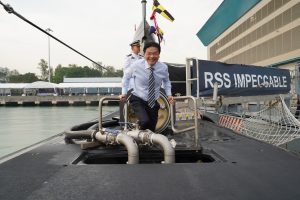On Tuesday, Singapore commissioned the first two of its four German-built Invincible-class diesel-electric submarines, marking a significant milestone in the long-planned upgrade of its submarine fleet.
The RSS Invincible and RSS Impeccable officially entered service as the Republic of Singapore Navy (RSN)’s fifth and sixth submarines following a ceremony at Singapore’s Changi Navy Base. Presiding over the ceremony, Prime Minister Lawrence Wong hailed the arrival of the two boats, which were launched in Kiel, Germany in 2019 and 2022.
“As a maritime nation, Singapore’s survival and prosperity depend on free and unimpeded movement over the seas,” he said during the ceremony, when, as per Reuters, the two new boats “were moored at adjoining piers, decked in colorful naval pennants, with their X-shaped rudders peeking from the water.”
“The RSN plays a critical role in keeping our sea lines open and secure,” Wong added.
The submarines, which measure 70 meters in length and have a displacement of 2,200 tons, were built by Germany’s Thyssenkrupp Marine Systems (TKMS). They also feature eight torpedo tubes for heavyweight torpedoes.
The entry into service of the two submarines – two more, the Illustrious and Inimitable, have been launched and are expected to arrive in Singapore in 2028 – marks an important milestone in the modernization of Singapore’s submarine fleet – a necessity for a nation so reliant on free flows of maritime commerce. The history of Singapore’s submarine program dates back to the mid-1990s, when the RSN bought four Sjoormen-class submarines from Sweden, which it refurbished and renamed the Challenger class. These entered into service in 1999.
Before they could enter service, the old Swedish submarines had to be retrofitted to operate in the warm tropical waters that surround Singapore. As the Straits Times explains, this involved “replacing steel pipes with copper nickel iron ones to reduce corrosion, and installing a system to minimize barnacle growth on the submarine surface.”
This was followed by the purchase of two newer secondhand submarines from the Swedish government in 2005, which were renamed the Archer class. Two of the Challenger-class submarines were retired in 2015, a year after Singapore placed an order with TKMS for the two boats that could become the Invincible and Impeccable. For the first time, these would be designed to suit Singapore’s unique conditions and requirements.
“Custom-built for Singapore’s needs, these submarines possess state-of-the-art capabilities, including high levels of automation, significant payload capacity, enhanced underwater endurance, and optimized ergonomics,” the Singaporean Ministry of Defense said in a statement this week. With the new submarines now in service, the last two of the Challenger class are scheduled to be retired.
As detailed in an article by Gerry Doyle of Reuters, the Invincible-class submarine is equipped with “air-independent propulsion,” which uses fuel cells to generate electricity rather than a standard diesel engine. As a result, the propulsion system is “extremely quiet” and allows submarines to remain submerged for long periods. With many processes fully automated, the submarines also require a relatively small crew
While the submarines are arguably not as lethal as Vietnam’s Russian-made Kilo-class submarines, nor as advanced and durable as the nuclear-powered submarines operated by China, Russia, and the United States, they will enhance Singapore’s ability to patrol and surveil the busy waters on which its future security and prosperity depend.
“They are an excellent force multiplier,” Col. Fong Chi Onn, commander of Singapore’s submarine fleet, told Reuters. “And for a country as small as ours, we need all the force multipliers we can get.”

































